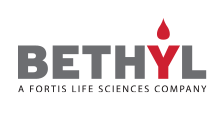NEW!
Rabbit anti-Chicken IgG (IgY) Heavy and Light Chain Antibody Biotinylated

Bethyl Laboratories
Catalog #
Target:
Chicken IgG (IgY)-Heavy and Light Chain
Reactivity:
Chicken
Applications:
DD
,ELISA
,Flow Cyt
,ICC
,IEP
,IF
,IHC
,WB
Host:
Rabbit
Clonality:
Polyclonal
Format:
Whole IgG
Isotype:
IgG
Conjugate:
Biotin
,FITC
,HRP
,Unconjugated
Purity:
Antigen Affinity Purified
,Antiserum
Antiserum (2 ml)
Unconjugated (1 mg)
Biotin (1 mg)
FITC (1 mg)
HRP (1 mg)
Product Details
Specifications
Verified Reactivity
Chicken
Antigen Species
Chicken
Concentration
1 mg/ml
Fluorophore/Protein
Storage
2 - 8 °C
Shelf Life
1 year from date of receipt
Physical State
Liquid
Buffer
Phosphate Buffered Saline (PBS) containing 0.2% BSA and 0.09% Sodium Azide
Request Formulation Change
Phosphate Buffered Saline (PBS) containing 0.2% BSA and 0.05% Pro-Clean 400
Request Formulation Change
Phosphate Buffered Saline (PBS) containing 0.09% Sodium Azide
Request Formulation Change
Serum containing 0.09% Sodium Azide
Request Formulation Change
Production Procedures
The antibody was isolated by affinity chromatography using antigen coupled to agarose beads and conjugated to fluorescein isothiocyanate (FITC).
Prior to conjugation, immunoglobulin concentration was determined using Beer’s Law where 1mg/mL IgG has an A280 of 1.4.
F/P ratio is 3.5.
By immunoelectrophoresis and ELISA this antibody reacts specifically with chicken IgG and with light chains common to other chicken immunoglobulins. No antibody was detected against non-immunoglobulin serum proteins. This antibody may cross react with IgG from other species.
Additional Product Information
Anti-heavy- and light-chain antibodies are designed to react with the whole intact Ig molecule. Found in all body fluids and a primary means of protection against infection, an anti-H+L IgG antibody allows for some potential cross-reactivity to other Ig molecules and IgG molecules from other closely-related species.
Applications

